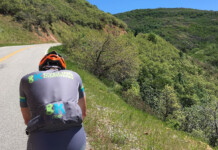By Tom Jow
What is cyclocross? Cyclocross, or ‘cross, is a mixture of running, log hopping, and road racing on a variety of surfaces including dirt, pavement, and grass all on a modified road bike with knobby tires. Besides being the fastest growing category of bicycle racing, it is also the most leg burning fun you can have on a bicycle in less than one hour.
One of the best things about cyclocross is that no special bike is required to get started. Oh sure, ‘cross fanatics have everything the pros have; multiple bikes and spare wheels, some even have their own personal pit crew. On the other hand, many of the racers ride their regular mountain bikes. Heck, there’s even a single-speed category!
The least expensive way to try out ‘cross is on a mountain bike. A hard tail frame works great because it is a little lighter (you’ll be picking the bike up several times per lap) and there’s no suspension to sag while sprinting out of corners. If you’ll be using a full suspension bike, minimize the suspension effect by adding 10-15 psi in both the front and rear shock. This will make the bike a little more responsive for sprinting. Avoid the temptation to use only the shock lockout because it can cause damage to the shock if over used.
Remove accessories such as bar-ends, cages, and tool kit. The racing is close and the courses are tight so removing the bar-ends reduces the risk of getting snagged on a branch or the handlebars of a competitor. The races are also short, just thirty minutes for beginners and only an hour for pros, which eliminates the need for drinks. In addition, you’re always within walking distance of the car so tools and a flat tire kit is not necessary. Cyclocross courses often have many corners, which also means slowing and accelerating many times per lap. For a small investment, changing to narrower, lighter tires will help increase the quickness of the bike. Look for 26 inch tires with a width in the range of 1.5 to 1.9 inches. The narrower tire will also increase the tire clearance and will reduce packing up with mud on wet days. Riders with 29’er mountain bikes have an advantage in tire selection because they can use the same tires as 700c ‘cross bikes. Whether you change tires or not, be sure to pickup some “Slime” tubes or another type of sealant for the tubes to protect from the “Goat Head” thorns that are prevalent in Utah during ‘cross season. If you’re already using tubeless tires with a sealant, you’re all set.
Maybe, however, you’re ready for a ‘cross bike. What makes a ‘cross bike different and how should it be sized? A cyclocross bike is similar to a road-racing bike with a few unique characteristics. The two most noticeable differences are the cantilever brakes and knobby tires. The wide knobby tires (up to 38mm for amateur racing) combined with low tire pressures provide traction on the wide variety of surfaces to be encountered. The cantilever brakes provide not only greater braking power, but also more clearance for mud (and there will be mud) around the tires and frame. Other differences include the use of a smaller large chain ring, such as a 44 tooth, or maybe even a single front ring, and top mounted brake levers.
When sizing a cyclocross bike, the size and position will be similar to an all around road riding position. Resist the urge to purchase a smaller size frame unless the top tube is about the same length as your road bike. Once the correct frame size is obtained, the saddle height can be set the same or a little lower than the road bike. A slightly lower saddle will be more comfortable in rough terrain, allow the rider to move around to find the best traction and make dismounts and re-mounts easier. The handle bar reach can be about the same but a little higher than the road bike. A higher handlebar position will allow the abdomen to be a little more open for easier breathing and make it easier to ride in the drops, which is a more powerful and better bike handling position.
All this technical talk aside, one of the great things about cyclocross is that everyone is welcome on any bike. This includes mountain, road and ‘cross bikes; even single speeds and unicycles! It’s no wonder that cyclocross has grown so much; it has courses that are compatible with every skill and fitness level and are extremely spectator friendly. It’s muddy, it’s clean, and some people even wear costumes. ‘Cross is just plain fun.








